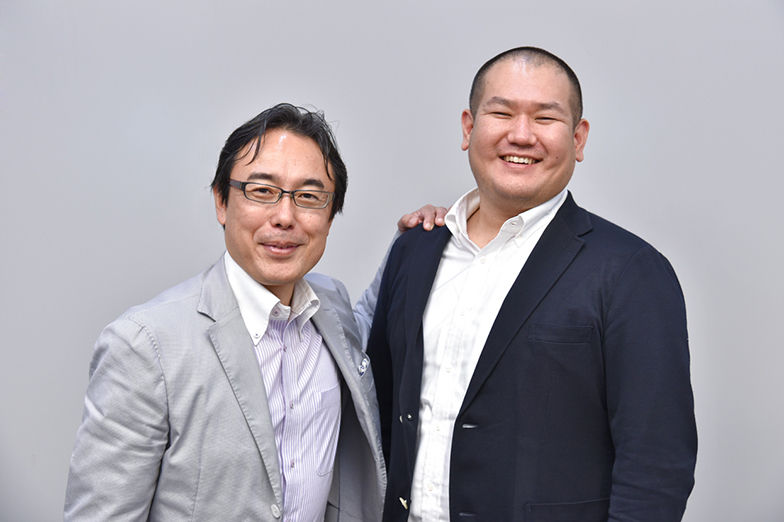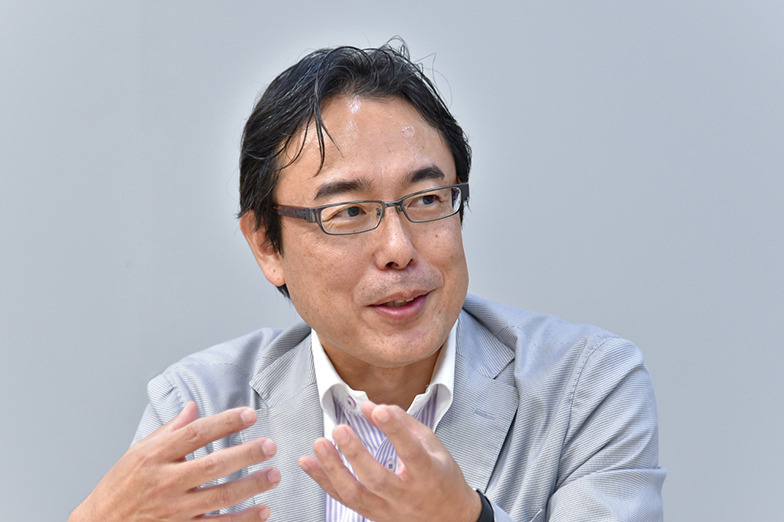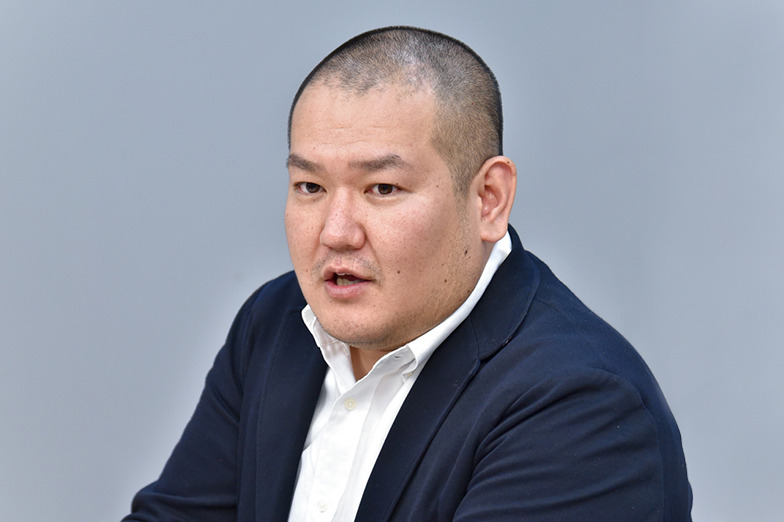
From left: Mr. Asaoka, Mr. Kagata
Experience value promised to future consumers = "Livelihood Words"
The themes covered in the first three installments of this series were established methods within the experience domain. However, this time, 'Nariwai Word' is an original concept devised by the Dentsu Inc. team, representing a slightly deeper concept than a mere method. In a nutshell, it is "the experiential value a company promises to 'provide' to its customers going forward." It can also be seen as a declaration of intent: "We will pursue this 'nariwai' (livelihood) from now on, so let's do it together."
One reason we considered the concept of "promising the future" so important was that, while consulting with client companies, we identified "time" as a key challenge. Experience is often perceived as solely about the "space" where it occurs, but we've come to understand that temporal continuity is equally vital.
Right now, my team is actively developing corporate "livelihood words," and recently we announced the "Dentsu Inc. Future Experience Innovation Program" based on our track record. This time, together with Chief Marketing Planner Kagata, who is involved in these projects as the field lead, I'd like to explore experiences through the lens of "time" and "livelihood," using case studies.
Launching a specialized team to envision future businesses proved challenging
Asaoka: Our department, the "Experience Marketing Division," was previously a brand consulting team. Within that context, we came to see why "experience" is crucial because social media became widespread, and many phenomena emerged that weren't covered in the textbooks of Professor D. Aaker, the authority on brand theory and our mentor.
Traditionally, brands were defined as corporate assets, primarily representing stocked value. But this approach fails to capture the value of flow—the dynamic, shared value represented by the recommendations and evaluations flying around on social media. We realized that unless we incorporate this flow information as part of brand value, our approach is no longer sound. This led us to the necessity of marketing that includes a new axis: "experience," encompassing both stock and flow.
Kagata-kun joined the team this spring, about two years after I started advocating these ideas. Previously, you handled marketing more focused on product development, right?

Kagata: Yes, I worked on developing advertising strategies for new products and collaborating with creators on their production, as well as designing training programs for corporate product development departments. However, ensuring every new product launched successfully became increasingly difficult in recent years, and I often found myself grappling with these challenges alongside corporate clients.
Kagata: Yes, I worked on developing advertising strategies for new products and collaborating with creators on their production, as well as designing training programs for corporate product development departments. However, it's become increasingly difficult in recent years for all new products hitting the market to gain a foothold. I often found myself grappling with these challenges alongside corporate clients.
Asaoka: I completely agree. In fact, even just since this spring, corporate demand for experience design has been high, and case studies are steadily increasing. As a result, we recently announced the "Dentsu Inc. Future Experience Innovation Program" to support designing these future experiences.
Kagata: Working alongside Asaoka, what surprised me first was the heightened sense of crisis among leading companies. The Tokyo Olympics in 2020, seen as the "near future" in Japan now, is already factored in. Looking beyond that, toward 2025 and 2030, major corporations have executives in charge of corporate planning leading projects and establishing task force teams to steer their course. However... compared to the effort being put in, I get the impression it's proving difficult.
In an era where unexpected competitors emerge, redefining one's livelihood is essential
Asaoka: A major reason is undoubtedly the siloed organizational structure. The larger the company, and especially when its core business is strong and divisions hold significant power, the more the entire company tends to focus on immediate sales. This makes it difficult for cross-departmental initiatives focused on the future to gain traction.
This is true for the "livelihood words" we've highlighted as a theme this time. Projects that require the collective wisdom of the entire company—like considering what experiential value to offer future customers—struggle to bring that wisdom together.
Fundamentally, while it's now established as a service line, even the corporate cases I've handled in recent years didn't start with the preconceived notion of implementing a future experience design program... Teams formed out of a sense of crisis that 'this can't go on,' but things didn't go smoothly. When considering how Dentsu Inc. could respond to such consultations, we realized that traditional approaches like creating corporate visions or communication development methods no longer worked. That's why we evolved it, shifting it more towards business strategy.
Kagata: I assume it's heavily customized for each company, but did the program's core framework itself change significantly before I joined?
Asaoka: There were several turning points, but a major insight was recognizing the importance of defining "livelihood words" in experience design. Another key was incorporating the concept of "time."
"Livelihood Words" clearly articulate, from the customer's perspective, the experiential value the brand will provide in the future. While "livelihood" is a long-standing term, we don't use it simply to describe current industries like automotive manufacturing or food retail. Instead, we use it as a way to redefine what the company will rely on for its future sustenance.
Why is this "re-framing" necessary? One reason is that narrow competition within traditional industry boundaries alone will no longer suffice to win in the global marketplace. For an automaker, competitors used to be other manufacturers within the automotive industry. But once autonomous driving (self-driving) becomes mainstream, it's obvious that IT companies and electronics manufacturers will become competitors. If you narrowly define your livelihood as "automobile manufacturing" at that point, you won't be able to compete. That's why redefining is necessary.
Bondsstrengthened by "time"are also part ofexperiential value
Kagata: Indeed, I feel cases where unexpected companies become competitors are increasing. Or even entire categories disappearing. At CES held this January (the annual U.S. consumer electronics trade show), many CEOs mentioned the keyword "Disruption." That disruptive change is happening.
Asaoka: Exactly. Decades from now, electronics manufacturers and IT companies might have to compete using the same "livelihood words." Preparing for such a situation makes defining those "livelihood words" crucial.
Equally important is that the language representing corporate value is shifting from adjectives to verbs. What matters to consumers is no longer specifications like "cool" or "fast," but rather what they "feel" and how they "act" through a company's products or services. If automakers and IT companies become competitors, for example, "moving fast and safely" becomes the experiential value provided. The "livelihood word" as the brand's future promise would then be "providing services for moving fast and safely." In other words, experiential value will become the brand's greatest differentiator.
Kagata: "To move" – it definitely is a verb. Another point you mentioned about the program's evolution, "time," makes perfect sense now that I'm actually involved in developing companies' "livelihood words."
Asaoka: When discussing brand experiential value, we tended to focus on the "space" where the experience occurs. But through consulting, I've come to see the bonds formed through temporal continuity as equally important to the experience. I'll elaborate later, but essentially, it's about "affection."
Fundamentally, when a company looks to the future and thinks about itself and its customers, that thinking inherently includes a time dimension. So, over the past year or so, our activities have been about incorporating the idea into experience design that value created over time is also experiential value – not just considering an experience at a single point in time.
The Case of Company A in the Housing Equipment Industry: A Movement Emerged Internally
Asaoka: Now, I'd like to introduce a corporate case study from this summer involving Company A, a residential equipment company, which Kagata-kun was responsible for.
Kagata: For our industry, the trend of an aging population and the growing mindset of adapting current homes rather than building new ones is driving increased demand for renovations, creating a tailwind. However, Company A fully anticipated the emergence of the "unexpected competitors" mentioned earlier. Over a year ago, they formed a dedicated team to explore future competitive axes and held numerous discussions.
That team established an initial strategy, and with their technical capabilities, they were also advancing initiatives like IoT. However, it wasn't quite becoming a company-wide movement. It was at this stage that we were called in to assist.
Asaoka: Among our department's projects, the client's task force team was involved in a very large-scale project, right?
Kagata: That's right. About 50 people from 6 or 7 departments participated in the program. We held three intensive workshops during July. While everyone had discussed what to offer future customers many times before, we brought in an "outsider's" perspective to help them rethink the future with the customer as the subject.
We set aside discussions about technological evolution and focused instead on how customers' lives and mindsets would change, and how we could be useful in that context. As a result, by the first day, a strong sense of crisis emerged... There was a palpable shift in the atmosphere, a feeling of "This is bad."
Asaoka: When discussions happen only among people inside the company, even when we say we're customer-centric, we often drift back toward corporate logic. But by having an outsider like Mr. Katagata constantly question whether we were truly adopting a customer-centric viewpoint, a sense of crisis began to emerge from within.
Kagata: That's right. I joined as a facilitator, but I noticed many things precisely because I had an outside perspective – like thinking, "The theory might hold, but will customers really change so conveniently?" Once that sense of crisis was shared, it became a powerful driving force that led us to verbalize the "livelihood words." Already, based on this, we've defined new areas the company will venture into. Plans for products representing new businesses have also emerged from ideas and technologies that were dormant in the research lab.
What gave me the greatest sense of accomplishment was how, within just one month, the enthusiasm of these roughly 50 people spread throughout the company, creating a bit of a festive atmosphere. Since it's a large corporation, 50 people represent only a small percentage. But I was delighted to hear, for example, that an executive from a department that didn't participate said, "I definitely want to join next time."
Our role isn't just to provide consulting and then leave. We aim to support the communication needed to reach the next stage: earning customer trust through ongoing product development, using that trust as the engine driving the company forward, and spreading the mindset that "we are changing" throughout every corner of the organization.
Asaoka: This is a case where the future developments are also exciting. Thinking from the customer's perspective is like Dentsu Inc.'s DNA, and this was a case where they experienced it firsthand through facilitation.










